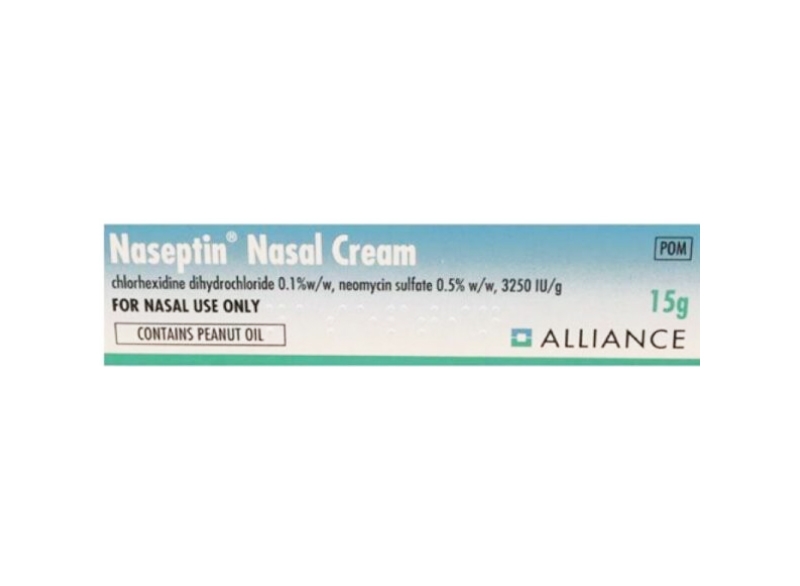Naseptin nasal cream is used to treat nasal infections caused by Staphylococcus aureus, including methicillin-resistant strains (MRSA). Its formulation combines chlorhexidine, an antimicrobial agent, and neomycin, a broad-spectrum antibiotic, which work together to reduce bacterial colonization in the nasal passages.
The efficacy of Naseptin is well-documented, with studies showing significant reductions in nasal carriage rates of Staphylococcus aureus after a standard treatment course of
approximately 10 days. Patients often experience fewer bacterial infections and a decreased risk of complications related to Staphylococcus aureus nasal carriage, making it particularly beneficial for those undergoing surgical procedures or individuals with weakened immune systems.
By effectively targeting the bacterial load in the nostrils, Naseptin nasal cream plays a critical role in infection control and helps improve overall patient outcomes in cases of nasal infection.
Apply a small amount of Naseptin cream, approximately the size of a pea, to each nostril. This application should typically be done twice daily for a duration of about 10 days, or as directed by a healthcare provider.
To apply, gently squeeze the tube to release the cream and use a clean finger or cotton bud to spread it inside the nostrils, ensuring that it covers the inner nasal membranes. It is important to avoid touching the tip of the tube to the nostrils to prevent contamination.
Patients should continue the full course of treatment even if symptoms improve before completion to ensure optimal efficacy. If a dose is missed, it should be applied as soon as remembered unless it is nearly time for the next dose; in that case, the missed dose should be skipped. Always follow healthcare provider recommendations regarding any changes to the dosage or duration of treatment.
Always use this medication exactly as your clinician has told you. Check with our clinical team or your GP or pharmacist if you are not sure.
Medicines and their possible side effects can affect individual people in different ways. The following are some of the side effects that are known to be associated with this medicine. Just because a side effect is stated here, it does not mean that all people using this medicine will experience that or any side effect.
Naseptin nasal cream may cause side effects, though many individuals tolerate it well. Here are the potential side effects associated with its use:
Common Side Effects:
1. Nasal Irritation: Mild irritation or discomfort may occur in the nasal passages after application, including a burning or stinging sensation.
2. Allergic Reactions: Some users may experience localized allergic reactions, such as:
- Itching
- Redness
- Rash around the application site
3. Dryness: Prolonged use can lead to dryness in the nasal mucosa, resulting in discomfort or crusting.
Serious Side Effects:
1. Gastrointestinal Symptoms: Though uncommon, ingestion of the cream (accidental swallowing) may lead to gastrointestinal upset, including:
2. Superinfection: Prolonged use of any antibiotic can lead to overgrowth of non-susceptible organisms, including fungi, resulting in secondary infections.
Other Considerations:
Precautions for Sensitive Skin: Individuals with sensitive nasal mucosa or a history of nasal surgery should use the cream with caution.
Drug Interactions: It is essential for patients to inform their healthcare provider of all medications they are currently using, as there may be interactions that could increase the risk of side effects.
Monitoring:
Patients using Naseptin are advised to monitor for any unusual symptoms or signs of severe reactions, especially during the initial period of use. If any serious side effects occur, or if local irritation persists or worsens, they should seek advice from a healthcare professional promptly. For full information on side effects and correct use, see the patient information leaflet. If any side effects concern you, or you are experiencing any of the side effects mentioned in the patient information leaflet whilst taking this medication, please contact our clinical team or speak to your GP.
Cautions:
- Known allergy to neomycin or chlorhexidine
- History of nasal surgery
- Sensitive nasal mucosa
- Avoid contact of the cream's applicator with nostrils
- Monitor for nasal mucosa dryness with prolonged use
Warnings:
- Risk of severe allergic reactions (anaphylaxis)
- Symptoms requiring immediate medical attention:
- Swelling of face or throat
- Difficulty breathing
- Severe dizziness
- Inform healthcare provider of other systemic antibiotics or immunosuppressive medications
- Follow healthcare provider recommendations for safe and effective use
Get emergency medical help if you have signs of an allergic reaction to this medication. These include:
- Hives
- Dizziness
- Fast or pounding heartbeats
- Wheezing
- Difficult breathing
- Swelling of your face, lips, tongue, or throat.
It is important that you let us know which prescription, over-the-counter medicines and recreational drugs you are currently taking. You must also tell us about any other medical conditions that you currently have (or had in the past). This will help us ensure the prescribed medication is safe and appropriate for you to take.
For full information on warnings, medication interactions and contraindications, refer to the Patient Information Leaflet. Please read all packaging and the Patient Information Leaflet before taking any new medicine and inform our clinical team or your GP of medicines you are taking or intend to take.







